We Tested 10 Boning Knives—Two Flexed on the Competition
Dotdash Meredith and Yahoo Inc. may earn commission or revenue on some items through the links below.
Our top picks are from Victorinox and Global.
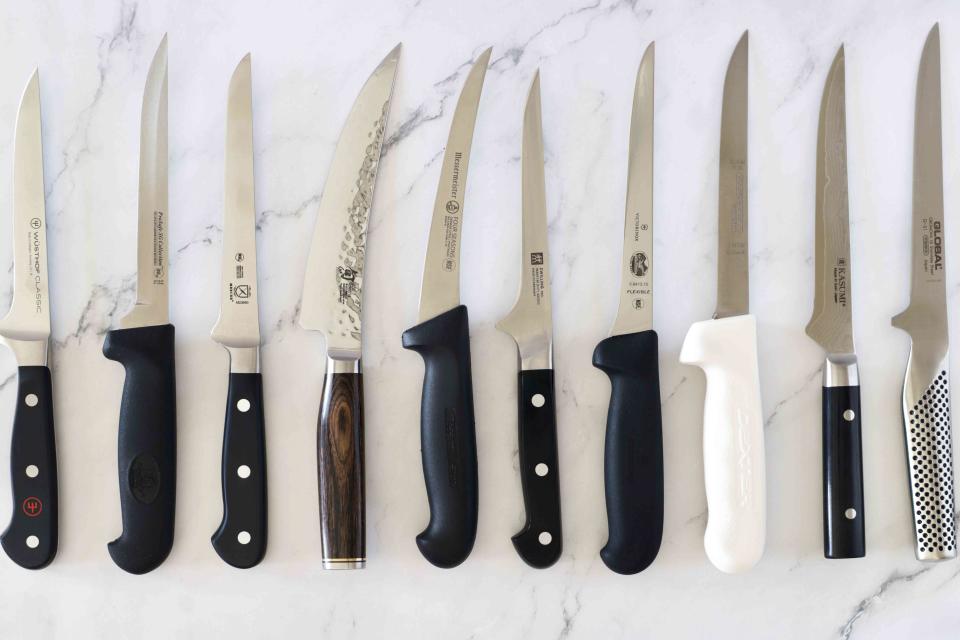
Serious Eats / Ashlee Redger
The best flexible boning knife is the Victorinox Fibrox Pro 6-Inch Boning Knife. Not only is it a breeze to use with its straight edge and grippy handle—it's affordable, too. We also liked the Global 6.25” Boning Knife because of its particularly sharp and bendy blade.
There are few kitchen tasks that bring me greater joy than breaking down a chicken. Not only is it cheaper than buying poultry by the piece, but it also encourages me to use every bit. When I’m done with the meat, I still have the resource-rich trimmings with which I can make stock and render the fat. (Have you ever drizzled chicken schmaltz over popcorn? Because you should.)
Sure, you can conquer a chicken with a chef’s knife—but a boning knife is specifically designed for the job. The long blade can cleanly slice the breast off of the ribs in a few strokes, and the sharp tip can be inserted into the joints to separate the legs and wings. Of course, a boning knife is not only for chicken. It can also be used to remove the skin from fish fillets, debone and trim silverskin off of pork roasts, and cut your own steaks. Tough-skinned produce like melons and squash? A boning knife can slice the thick rinds off with no problem.
Because they can be used for many tasks, boning knife blades come on a scale from rigid to downright bendy. Stiffer blades can stand up to larger cuts of meat and cut through thick joints, whereas flexible knives are better suited for detail work. For most cooks (who aren’t dealing with whole beef or pork primals at home), boning knives are more versatile for cutting around smaller bones and sliding between joints, like the aforementioned chicken legs, or cutting a rack of lamb into chops.
For this review, I focused on boning knives with flexible blades that were between 5 and 6.5 inches long. Their costs ranged from $14 to $170. I preferred blades that were more pliant and judged them on their ability to contour around bones to access the maximum amount of meat. While the shape and balance of a knife’s handle can be a matter of personal preference, I prioritized grip when my hands became wet or greasy from what I was cutting. The competition was tight, and almost every model had something that set it apart from the rest. The winning knives ultimately stood out because they balanced all three of my top factors: a razor-sharp edge, an agile blade, and a comfortable grip.
The Winners, at a Glance
Victorinox 6-Inch Fibrox Pro Flexible Boning Knife
The Best Overall Boning Knife

The Victorinox knife was an all-around pleasure to use. Its blade was flexible enough to conquer each task with ease, plus it was super sharp. The handle was textured, which allowed for superior grip, even when my hands had water or grease on them.
Global 6.25" Boning Knife
Alternative Pick

This model kept a keen edge throughout testing and was the most flexible of the lineup. It made larger tasks—like carving whole chickens or deboning a pork shoulder—simple and fast.
The Tests
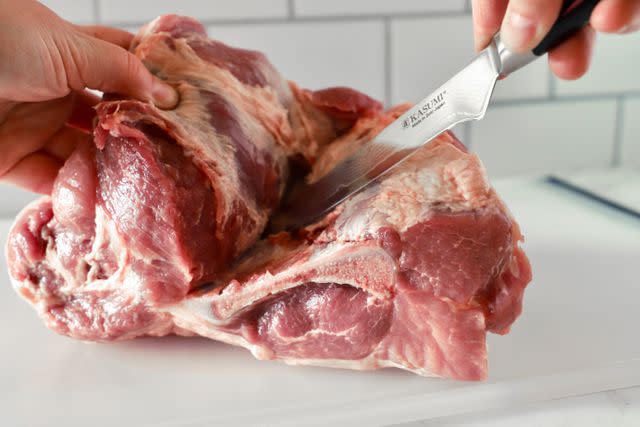
Serious Eats / Ashlee Redger
Blade Sharpness Tests: I used a professional blade edge tester to measure the sharpness of each knife right out of the box. I tested all of the edges again at the end to see if any dulled after use. I measured the force (in grams) necessary for the knife to sever a calibrated plastic wire. The lower the score, the sharper the knife.
Debone Chicken Thigh Test: I deboned a chicken thigh with each knife to determine its maneuverability and nimbleness. After this assessment, only the highest-performing knives moved onto the subsequent tests.
Trim Pork Tenderloin Test (Winners-Only): To measure control, I trimmed a pork tenderloin with each knife and judged how well it could cleanly remove thin layers of fat and silverskin.
Bone-In Pork Shoulder Test (Winners-Only): I deboned and butterflied a pork shoulder with each knife to test its ability to dexterously navigate and flex around a large, multi-sided bone. I also trimmed off excess fat and silverskin around the remaining meat.
Rotisserie Chicken Test (Winners-Only): I carved store-bought rotisserie chickens with the top performers. With each model, I observed how deft it was at slipping through cartilage to separate joints. I also assessed if the blade’s flexibility allowed it to curve around the breast bones to yield as much usable meat as possible. Lastly, I noted if the knife’s handle became slippery after it was coated in grease from the chicken.
Cleaning and Usability Tests: I hand-washed and dried the knives after each test to evaluate how easy they were to clean and if any displayed rusting or staining. While a few of the models tested were technically dishwasher safe, hand-washing was strongly recommended for all of them—and it’s what we recommend here at Serious Eats. I also judged each knife on how comfortable and natural it felt in my hand during use.
What We Learned
Greater Flexibility Was Better for Getting Around Bones
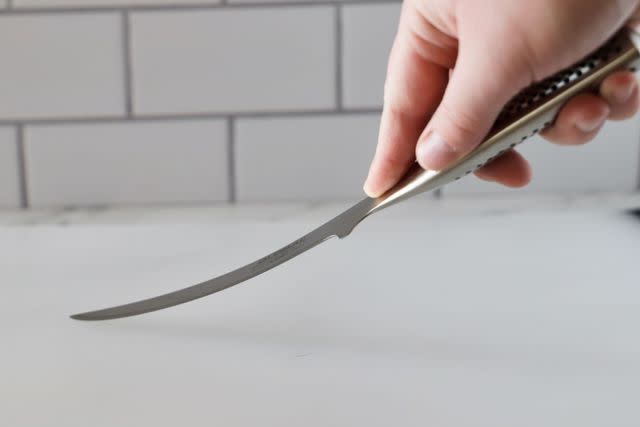
Serious Eats / Ashlee Redger
During testing, I preferred blades that were supple and that easily flexed while slicing. The ZWILLING Pro 5.5-inch Flexible Boning Knife and Victorinox Fibrox Pro 6-Inch Boning Knife were both great examples of this—they perfectly conformed to the breast and rib bones in the rotisserie chicken test to slice off every bit of white meat.
The Global 6.25” Boning Knife was the most flexible of the bunch. Its long blade was able to contour around the big, twisted bone of the pork shoulder without difficulty. On the other hand, the Wüsthof Classic 5” Boning Knife made the task difficult. Its short length and light flexibility were great for deboning chicken thighs and trimming pork loin, but it didn’t have the reach or the litheness to slice around the pork scapula without carving out extra meat.
Read More:We Tested 30 Chef’s Knives to Find Our Favorite Multitaskers
Straight Blades Were Easier to Use
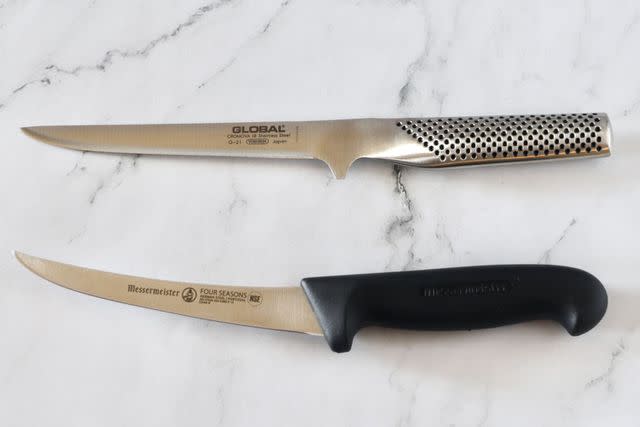
Serious Eats / Ashlee Redger
Two of the models I tested had curved spines that arched upwards toward the tip: the Shun Cutlery Premier 6” Boning & Fillet Knife and the Messermeister Pro Series 6-inch Flexible Curved Boning Knife. This is a common silhouette for both boning and filleting knives as it creates a longer bottom edge without making the knife feel lengthy and unbalanced. It can make some special tasks easier—for example, removing the skin from a long piece of fish—as it allows the knife to cut further along the meat in a single, smooth stroke. I preferred the versatility of straighter knives, though, which had level spines from tip to bolster. The straight blades were more predictable and easier to maneuver around small chicken bones. Their tips were also better at removing pockets of fat and made it easy to insert the blades into hard-to-reach joints.
Handle Design Was Important for Comfort and Safety
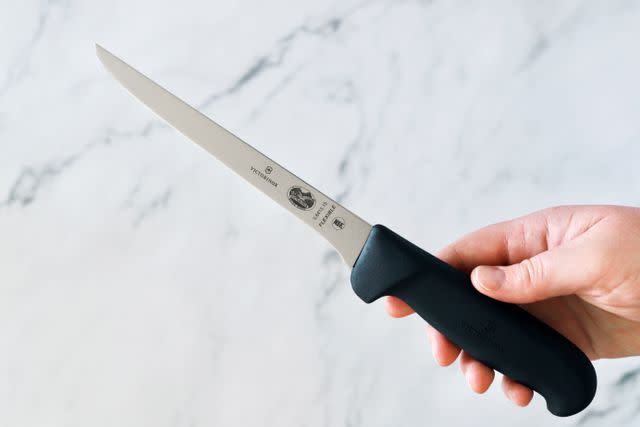
Serious Eats / Ashlee Redger
We liked the rounded, grippy handle on the Victorinox boning knife.As with all knives, what makes a handle feel comfortable varies depending on who is holding it. In contrast with a chef’s knife where you basically maintain a single grip from start to finish, I looked for boning knife handles that made it easy to alternate my hold depending on which direction I was cutting. This helped when I was pressing the blade against a bone, trimming off a horizontal layer of silverskin, or directing the tip down into a joint.
I loved the rounded handle of the Kasumi Flexible Boning Knife and could easily shift my hold on it when it was dry. Once my hand got wet, though, it became difficult to get a safe grasp on the smooth, cylindrical handle. Comparatively, the Dexter Russell Sani-Safe 6” Flexible Boning Knife had a rough textured handle that made it feel secure, but its oversized bolster and indented handle made it awkward to move around.
The Victorinox offered the best middle ground. Its thermoplastic rubber handle was grippy enough to feel secure (even when it was coated in chicken fat) while its rounded shape was comfortable to reposition in my hand. The stainless steel handle of the Global did get a little slippery during the rotisserie chicken test, but the dimples in the handle helped provide enough grip so it did not become dangerously slick.
Sharper Was Better
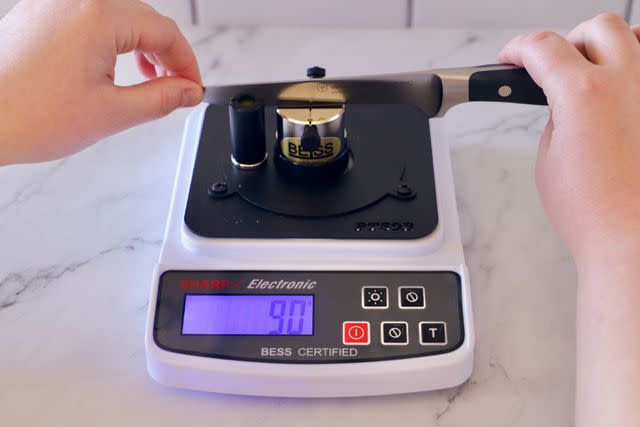
Serious Eats / Ashlee Redger
Unsurprisingly, boning knives that were sharper performed better. The two sharpest knives were the Wüsthof and the Victorinox, which both scored around 100 on the out-of-the-box sharpness test (remember, lower scores are better here). Both of the knives easily slipped through cartilage and beneath thin silverskin, and they weren’t the only ones. More than half of the models maintained a sharpness score below 150, even after cutting against bones in later tests. Duller knives like the Dexter Russell and the BergHOFF Soft Grip 6” Narrow Flexible Boning Knife had a hard time slicing through slippery chicken skin and under thin layers of fat, so they were quickly knocked out in the early rounds of testing.
The Criteria: What to Look for in a Boning Knife
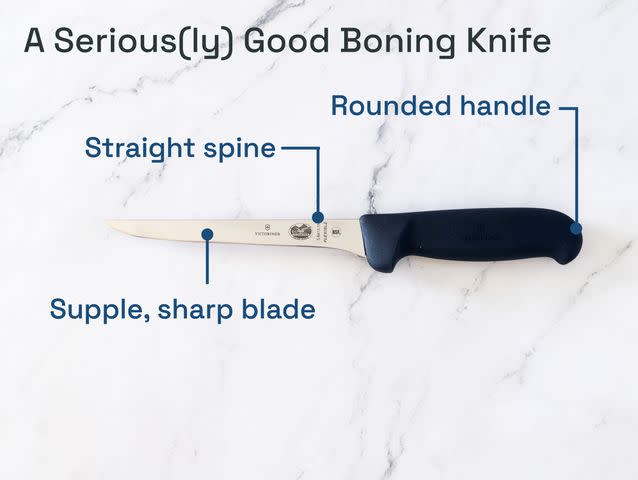
Serious Eats / Ashlee Redger / Grace Kelly
A good boning knife should have a blade that is supple enough to curve around bones and cleanly slice off meat. Its spine should be straight rather than curved for better accuracy and ease of use. The sharper the knife’s edge, the better it is at separating joints and trimming off fat or silverskin. Rounded handles make the knife more comfortable to hold and shift positions, while a grippy texture provides extra safety from slips.
Victorinox 6-Inch Fibrox Pro Flexible Boning Knife
The Best Overall Boning Knife

What we liked: Like many of its competitors, this knife was super sharp. It effortlessly sliced through joints and shaved off silverskin and fat without cutting away excess meat. It had enough flexibility to contour around bones, both big and small. But what truly set it above the rest was its handle, which was textured and provided grip even when it was wet or coated with chicken fat.
What we didn’t like: Although the rubberized handle texture provided a secure grip, I found the broad handle to be a tad bulky.
Price at time of publish: $22.
Key Specs
Weight: 2.85 ounces (81 grams)
Handle material: Thermoplastic rubber
Blade material: High carbon stainless steel
Blade length: 6 inches
Blade height at broadest part: 0.75 inches
Spine thickness at widest point: 1.25 millimeters
Handle length: 5 inches
Handle width at widest point: 1.25 inches
Out-of-the-box sharpness average: 102 (utility razor blade-sharp)
After-testing sharpness average: 125
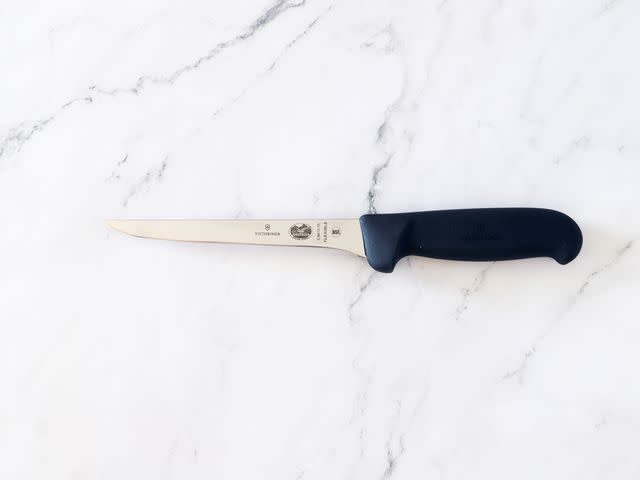
Serious Eats / Ashlee Redger
Global 6.25" Boning Knife
Alternative Pick

What we liked: This knife’s sharp edge took no coaxing to slice into thick pork shoulder and trim off thin pieces of silverskin. The Global also had the most flexible blade of the lineup, which hugged chicken and pork bones as it glided around them.
What we didn’t like: This knife is made from a single piece of stainless steel. While the unbolstered handle is dimpled to provide some grip, the metal still got a little slippery when my hand was wet. The bendy blade was also quite long. This makes it ideal for turkey, pork, or filleting whole fish, but less suited for small tasks like deboning single chicken thighs. Compared to the Victorinox, it’s also quite pricey.
Price at time of publish: $110.
Key Specs
Weight: 4.4 ounces (125 grams)
Handle & blade material: CROMOVA 18 stainless steel (a blend of chromium, molybdenum, and vanadium that is exclusive to GLOBAL)
Blade length: 6.25 inches
Blade height at broadest part: 0.75 inches
Spine thickness at widest point: 2 millimeters
Handle length: 5 inches
Handle width at widest point: 1.13 inches
Out-of-the-box sharpness average: 115 (utility razor blade-sharp)
After-testing sharpness average: 115
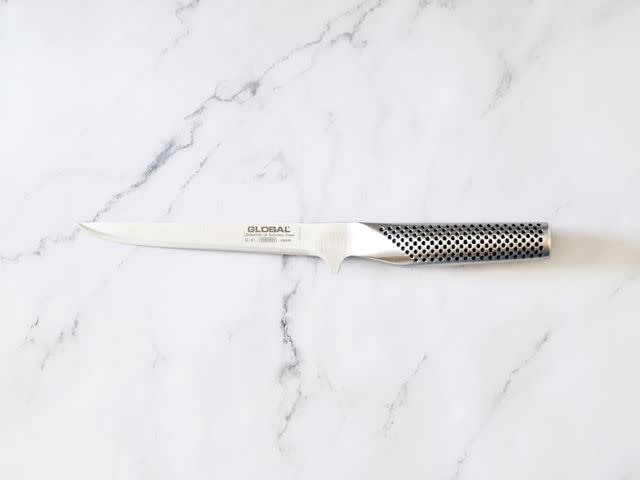
Serious Eats / Ashlee Redger
The Competition
ZWILLING Pro 5.5-inch Flexible Boning Knife: This model made it to the final round and performed nearly as well as the winners in every test. Its shorter blade made it easy to maneuver and had similar flexibility to the Victorinox. It was more expensive than both winners, though, and not quite as sharp. Its handle also became a little slippery during the rotisserie chicken test.
Kasumi Flexible Boning Knife: The Kasumi had a honed edge and effortlessly flexed its way around the bone in the pork shoulder test. Its major downside was its smooth, cylindrical handle, which became impossible to get a secure grasp on when it was wet.
BergHOFF Soft Grip 6” Narrow Flexible Boning Knife: The BergHOFF had the dullest edge of the lineup before and after testing, which made it less smooth when cutting through skin and cartilage.
Wüsthof Classic 5” Boning Knife: Although its edge got the best score in the sharpness tests (just a hair sharper than our overall winner), the shorter blade was not dextrous enough to maneuver around the bone in the pork shoulder without removing extra pieces of meat.
Shun Cutlery Premier 6” Boning & Fillet Knife: The Shun knife was keen and stunning in appearance, but the curved blade was unyieldingly rigid and difficult to use for precise cuts.
Messermeister Pro Series 6-inch Flexible Curved Boning Knife: Although it was less stiff than the Shun model, I still found the curved tip of the Messermeister awkward to aim and maneuver during the chicken thigh test.
Mercer Culinary Renaissance Flexible Boning Knife: This model’s performance did not stand out from its competitors. It was decently flexible but had some trouble cutting through slippery chicken thigh skin.
Dexter Russell Sani-Safe 6” Flexible Boning Knife: The handle on this knife was built for safety: it had a thick bolster guard separating one’s hand from the blade and was textured to provide grip. Unfortunately, it also felt clunky and hindered dexterity.
FAQs
What is a boning knife used for?
Boning knives are used for deboning, trimming, and slicing all kinds of animal (or fish) proteins. Their narrow blades can range from rigid (for cutting through thick cartilage) to flexible (for bending between bones and the surrounding meat). The knives can be straight or curved upwards at the spine. One of the defining features of a boning knife is its small, sharp tip, which is designed to be inserted down into joints to sever the connective tissues within.
What is the best size for a boning knife?
Boning knives tend to be between five to seven inches long. The best size depends on user preference and task: longer knives can have a greater range of flexibility and are best for deboning beef, pork, game meats, and breaking down whole poultry or fish. Shorter knives are often less flexible and are adept at deboning chicken legs, filleting small fish, or even peeling hardy fruits like pineapple.
What is the best way to clean a boning knife?
Hand-washing is recommended for all knives. Use mild dish soap, a non-scratch sponge, and warm water. Once the knife is clean, dry it immediately to prevent rusting. Store all knives in a protected place, like on a magnetic knife strip or in a cork-lined dock, to prevent damage to your blades (and fingers).
How do you sharpen a boning knife?
Contact with hard surfaces like bones can dull a knife’s edge quickly, so it’s important to keep your boning knife sharp to keep it working efficiently. You can use a whetstone to sharpen your blade at home. Whetting any knife at home can take practice; the process varies depending on the shape and material of the individual knife, as well as personal preference for bevel and edge finish. If you don’t have the time or equipment to sharpen at home, a professional sharpener can expertly file the blade for you. Either way, we recommend a honing rod for maintaining the edge between sharpenings.
What is the difference between a boning knife and a filleting knife?
Boning and filleting knives look very similar and are often used interchangeably. Both have long, thin blades—the edges of which can be either curved or straight. Boning knives are generally slightly thicker and sturdier so they stand up to hard bones and denser cuts of meat. They can be flexible, stiff, or somewhere in between. Filleting knives are usually longer than boning knives (as well as more flexible) and are primarily used for removing the skin and bones from delicate pieces of fish.
Read More:After Testing 9 Meat Cleavers, Four Winners Emerged

